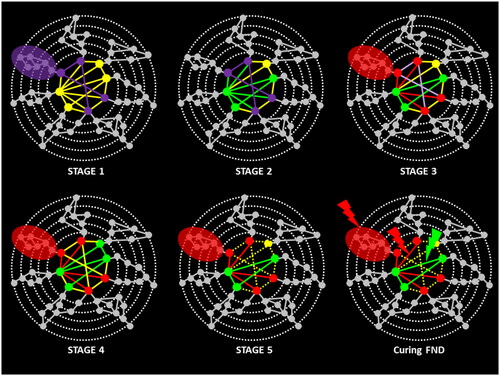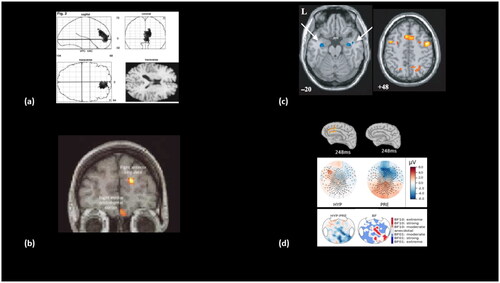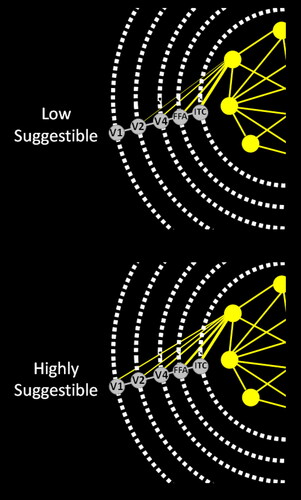Figures & data
Figure 1. A 5-stages GNW-based model of FND, and of therapeutic interventions.
Legend: Hierarchy of connections between brain processors is symbolised by concentric dotted circles (after (Dehaene et al. Citation1998; Dehaene and Naccache Citation2001) and (Mesulam Citation1998)). Each cortical processor is symbolised by a full disc. Higher levels of this hierarchy (i.e.: the most inner circle) are assumed to be widely interconnected by long-distance interconnections, thus forming a global neuronal workspace. An amplified state of workspace activity, bringing together several peripheral processors in a coherent brain-scale activation pattern (coloured ellipses), can coexist with the automatic activation of multiple local chains of processors outside the workspace (gray circles).
STAGE 1: Conscious access to an emotionally traumatic conscious feeling (for all coloured texts, see corresponding coloured components in the figure)
STAGE 2: Post-experiential voluntary & conscious process: « I would like to forget this feeling »
STAGE 3: Unvoluntary efficient inhibition of specific relevant networks through conscious influences on unconscious processes & through GNW-Murmur
STAGE 4: Conscious access to unvoluntary FND symptoms: « I can’t remember this period »
STAGE 5: Persistence of FND symptoms as long as Stage-2 and Stage-3 processes are actively maintained in GNW activity.
Curing FND: Targeting current symptoms (e.g.: C.B.T.) would act on stage-3 processes, whereas interventions (represented in the figure by coloured lightning symbols) targeting introspection of subjective interpretation of FND would act on stage-2 (e.g.: self-narrative and interpretative psychoterapies).

Table 1. Taxonomy of possible unconscious cognitive processes in a conscious individual.
Table 2. List of 12 predictions about FND.
Figure 2. Role of ACC in voluntary and conscious triggering of involuntary cognitive processes in FND, in hypnotic induction and in active forgetting.
Legend: According to our 5-stage model of FND, stage-3 would consist in GNW top-down control over specific cortical networks, and it is predicted to be a stage common to other conditions such as hypnotic induction and active voluntary forgetting. Several results support this prediction such as: (a) ACC activation during FND ‘palsy’ targets motor regions (Marshall et al. Cognition 1997); (b) ACC activation during Hypnotic ‘palsy’ targets motor regions (Halligan et al. Lancet 2000); (c) ACC activation during active forgetting targets hippocampi (Anderson et al. Science 2004) as an increase of activity in GNW areas including ACC associated to an inhibition of hippocampi areas; (d) ACC activation during Hypnotic ‘deafness’ targets conscious access to auditory cortices (Munoz-Musat et al. Front. in Neurol. 2022). Source estimation of high-density EEG revealed an ACC activation around 248ms post sound onset during the induced deafness condition (top left item), that was absent in the non-hypnotic condition (PRE condition, top right item). A proposed signature of conscious access (P3b ERP component) fully disappeared during induced deafness (middle figures), and right posterior sensors showed a strong decrease of functionally connectivity with other cortical areas during hypnotic deafness (bottom items; see Prediction 10 in the main text).

Figure 3. Hypnotic suggestibility and GNW neurons density in specific areas.
Legend: Illustration to visual perception of our prediction relating hypnotic suggestibility to an increase of GNW neurons density (in layers II-III) in corresponding cortical areas (see our Prediction #11 in the main text and in ). Such structural factor would enable increased top-down influence from GNW to targeted areas, with either excitatory (for positive symptoms such as hypnotic induction of visual hallucinations), or inhibitory (for negative symptoms such as hypnotic induction of blindness) effects. Schematic representation of the GNW bidirectional connections (yellow) with core areas of the visual ventral pathway (V1, V2, V4, Face Fusiform Area (FFA), Inferior Temporal Cortex (ITC)) are represented both for low-suggestible (top) and for highly-suggestible individuals (bottom). Bidirectional anatomical connections (GNW neurons) between key GNW areas and between GNW areas and peripheral visual areas are represented in yellow. According to our prediction number 11, responsiveness to visual suggestions (capacity for visual hallucinations) in some highly suggestible individuals should be at least partially mediated by an increased GNW neuron density in the ventral pathway, with more GNW neurons in high level visual areas (ex: FFA), and with the presence of some GNW neurons in regions normally lacking this type of neurons (ex: V1). Note that several GNW areas could be involved, including both high-level visual areas, as well as executive areas such as the dACC involved in top-down regulation. Conscious access and specific contents could be controlled through this top-down regulations. If confirmed this prediction could generalise to other conditions of GNW top-down control on specific networks such as: FND, mental imagery or synaesthesia.

